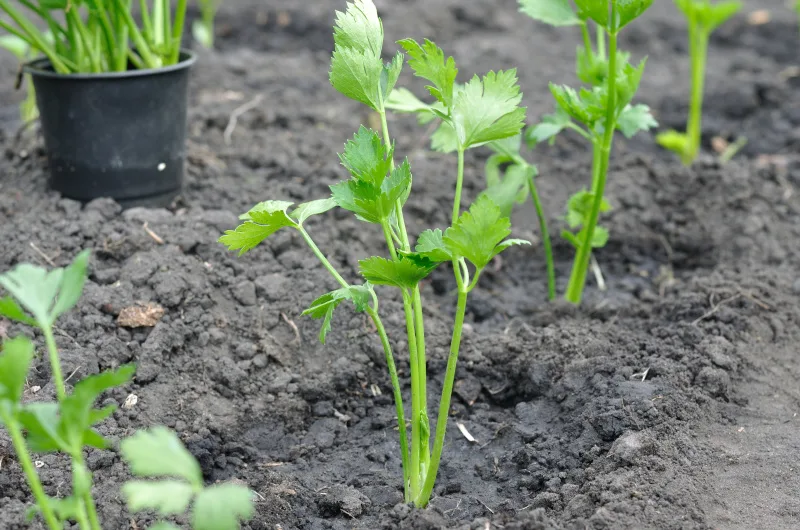How To Grow Celery
Growing celery (Apium graveolens) can be a rewarding and fulfilling endeavor for both novice and experienced gardeners alike. With its crisp, fleshy stalks and unique flavour, celery is a versatile vegetable that finds its way into salads, soups, and various dishes. It’s also an essential ingredient in soffritto, a real staple base used to add flavour and aromatics to many Italian dishes.
If you’re wondering how to grow celery and provide it with the care it needs to thrive, this article will provide you with a step-by-step guide, covering everything from selecting the best varieties to harvesting the perfect stalks.
Understanding Celery’s Needs
Before you delve into planting celery, it’s crucial to understand its specific requirements. Celery is a cool-season crop that prefers a relatively long growing season. It’s important to note that celery is a bit more demanding than other vegetables, so be prepared to invest time and effort into its cultivation. The following steps outline the best way to grow celery successfully.
Choosing the Right Varieties
There are different varieties of celery available, each with its own unique characteristics. Some popular options include green varieties like ‘Tall Utah’ and ‘Golden Boy.’ ‘Tall Utah’ is known for its tall, sturdy stalks, while ‘Golden Boy’ adds a touch of color to your garden with its yellow-green stalks. Select the variety that best suits your taste and growing conditions.
Starting with Healthy Seedlings
While you can grow celery from seeds directly in the garden, starting with seedlings provides a more efficient way to ensure a successful harvest. Begin by sowing celery seeds in seed trays filled with a high-quality potting mix. Sow the seeds thinly and cover them with a light layer of soil. Keep the seed trays in a warm and sunny spot, and within a couple of weeks, you should see the young plants emerging. Celery seeds are very small, so it’s important to only cover with the thinnest of layers of compost, and to take care when watering to avoid washing the seeds to one end of the tray – or even away altogether! Sowing in shallow rootrainers, then thinning to a single seedling per cell by snipping off the excess seedlings with a pair of scissors can be a good idea, to avoid damaging young seedlings, which can be quite fragile.
Timing Is Key
Celery is sensitive to frost, so it’s crucial to time your planting correctly. Plan to transplant your celery seedlings outdoors after the last frost date in your area. This usually falls in the early spring or early summer, depending on your location. Starting indoors and transplanting later gives your celery a head start and ensures it gets the warm weather it requires for healthy growth.
Providing the Right Growing Site
Celery thrives in rich, well-draining soil. Prepare the planting area by adding compost or well-rotted manure to enrich the soil’s nutrients. The soil should be slightly acidic to neutral (pH around 6.0 to 7.0). Choose a sunny spot in your garden that receives at least six hours of sunlight daily.
Watering Celery
Celery needs consistent moisture to grow well, but it’s important to strike a balance to avoid waterlogged soil. Keep the soil evenly moist by providing plenty of water, especially during dry periods. Using a soaker hose or drip irrigation can help deliver water directly to the soil, minimizing the risk of water splashing onto the leaves, which can lead to certain plant diseases.
Transplanting with Care
Once your celery seedlings have developed a few true leaves and the weather has warmed up, they’re ready to be transplanted into the garden. When transplanting, handle the seedlings gently to prevent transplant shock. Space the plants about 6 to 8 inches apart in rows that are 24 to 36 inches apart. Plant them slightly deeper than they were in the seed trays, burying the stems up to their first set of leaves.
Fertilising Celery
To support the growth of healthy and robust celery plants, provide them with a balanced fertiliser. Apply a slow-release fertiliser or a liquid fertiliser every few weeks according to the manufacturer’s recommendations. Avoid over-fertilisation, as this can lead to excessive foliage growth at the expense of stalk development.
Care and Maintenance
As your celery plants grow, be diligent in caring for them. Keep an eye out for common pests like aphids, snails, and slugs. Implement pest control measures if necessary, using organic methods such as wool slug pellets whenever possible. Mulching around the plants can help retain soil moisture and suppress weed growth, ensuring that your celery plants have the best environment for growth.
Protecting Celery from Plant Diseases
Celery can be susceptible to certain diseases, including downy mildew. To minimize the risk of disease, avoid overhead watering, which can encourage the spread of fungal spores. Ensure good air circulation around the plants by providing adequate spacing. If you notice any signs of disease, promptly remove and dispose of affected plant parts to prevent further spread.
Harvesting the Rewards
The moment of truth arrives when it’s time to harvest your celery. Depending on the variety, celery plants take about 85 to 120 days to mature from the time of transplanting. Harvesting typically takes place from late summer to early winter. Begin by cutting the outer stalks at the base, using a sharp knife or pruning shears. Leave the central stalks to continue growing for later harvesting.
Growing celery is a rewarding endeavour that requires attention to detail and a bit of patience. By providing the right conditions, from the proper soil and sunlight to consistent watering and care, you can cultivate celery plants that yield crisp, flavourful stalks. Remember to choose the appropriate varieties for your taste preferences and climate, start with healthy seedlings, and give your celery the best chance to thrive. With the knowledge gained from this guide on how to grow celery, you’ll be well on your way to enjoying the bountiful harvest of this versatile and nutritious vegetable.



